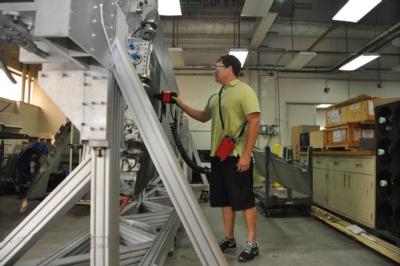Non-Destructive Inspection Saves The Taxpayers Millions Of Dollars, NAVAIR Says
An assignment to access the integrity of an MV-22 Osprey wing at Marine Corps Air Station (MCAS) New River in North Carolina earlier this year resulted in the validation of a non-destructive inspection (NDI) method that stands to save the Navy and Marine Corps millions of dollars in maintenance and repairs to the primarily composite-based airframe.

“The Diffuse Reflectance Infrared Fourier Transform (DRIFT) is a portable spectrometer that can determine if a composite is heat damaged. We developed it to serve that purpose,” said Naval Air Systems Command (NAVAIR) materials engineer Justin Massey. “It was originally invented for geological surveys, then we (modified) it with the help of Boeing to determine chemical changes in composite materials to find out if they are heat damaged or not.”
The handheld DRIFT detects chemical changes, such as those induced by heat, to composites on a molecular level. Weaken or damaged composites typically result in cracks or de-laminates to the component. “Boeing initially developed DRIFT for its 787 platform. Our team lead, Ed Harris, came up with the idea of developing it for the F/A-18. The development period was from 2012-2015, and it was officially adopted as an inspection method by NAVAIR in 2015 where it has been used on the F/A-18,” Massey said.
The DRIFT NDI procedure was qualified by Fleet Readiness Center Southwest (FRCSW) in 2015 to detect heat damage in F/A-18 composites using an Agilent Flexscan 4200 spectrometer.
The following year, a national team that included staff from FRCSW, FRC Southeast, FRC East, and Naval Air Warfare Center Aircraft Division (NAWCAD) was assembled to modify the DRIFT NDI for use on other airframes, including the V-22 Osprey. “With the national team, we took this technology and developed it for the V-22. It usually takes about two to three years to do something like this, but we got it done in two months to be able to inspect the V-22 wing (at MCAS New River),” Massey said. “The wing was thermally damaged from an engine fire, and there was no inspection technique to determine if it could be saved or not.”
Massey and NAVAIR materials engineer technician Steve Pacheco were joined by FRC East materials engineers Rob Thompson and Andrea Boxell, and with the help of the materials group and Fleet Support Team at Cherry Point, completed inspections and assessments on the V-22 wing after two days. “This was a onetime deal in that we got authorized through their program office,” Pacheco said. “It was an emergency because the aircraft was taking up an entire hangar bay, so they needed to know if they could fix it and fly it again, or part it out.”
The wing was recoverable, saving approximately $10-$12 million in replacement costs. “We’ve already saved about $20 million in aircraft parts over the past few years,” Pacheco said.
The DRIFT spectrometer cost about $60,000, and development costs were approximately $400,000. “Composites are high value assets, and the return on investment is relatively quick on this kind of technology,” Massey noted. “Prior to the development of DRIFT, visual inspections and standard NDI methods were used on composite parts. Generally, if the paint showed any discoloration, it was the removal and replacement of the part under analysis. Which is what would have happened on this V-22,” he said.
“We’re currently the only branch in the military that can detect heat damage on composites,” he said. “We see this use expanding to every aircraft that has composites. People have reached out to us from the Air Force, to the Army and the prime contractors. Everyone has caught wind of this and wants to know how to get this for their aircraft.”
A joint project by Massey, Thompson and Boxell entitled “The Use of DRIFT for Composite Heat Damage Evaluation of the V-22 Wing,” was submitted to the 2017 DOD Maintenance Innovation Challenge. It is one of six finalists from a field of 77 submissions. A winner will be selected at the DOD Maintenance Symposium in Salt Lake City Dec. 5.
(Image provided with NAVAIR news release. Materials engineer technician Steve Pacheco uses the DRIFT portable spectrometer to determine if the wing of a legacy F/A-18 sustained any heat damage)
 Airborne 04.16.24: RV Update, Affordable Flying Expo, Diamond Lil
Airborne 04.16.24: RV Update, Affordable Flying Expo, Diamond Lil ANN's Daily Aero-Term (04.20.24): Light Gun
ANN's Daily Aero-Term (04.20.24): Light Gun Aero-News: Quote of the Day (04.20.24)
Aero-News: Quote of the Day (04.20.24) Aero-News: Quote of the Day (04.21.24)
Aero-News: Quote of the Day (04.21.24) ANN's Daily Aero-Term (04.21.24): Aircraft Conflict
ANN's Daily Aero-Term (04.21.24): Aircraft Conflict



